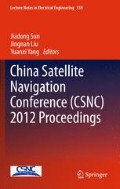Abstract
The increasing demands of position information have made the wireless location technology catch more and more attention nowadays. GPS (Global Positioning System) which has been widely used cannot localize successfully indoors and among buildings, its defects are increasingly prominent. Given the acceptable terrestrial digital television signals anytime and anywhere, as well as the advantages of high transmission power, low operating frequency and strict synchronization with absolute time, it is possible to achieve accurate positioning by Digital Television Terrestrial Multimedia Broadcasting (DTMB) and GPS. Electromagnetic waves have to propagate by deflection, refraction and scattering because of the obstructions in the surroundings of transmitting, we call it as Non-Line of Sight (NLOS) propagation, which results in NLOS errors [1]. In this paper we take some further study on the method of NLOS error mitigation based on the hybrid positioning system combining DTMB and GPS in view of a large number of obstacles in the urban environment. This algorithm, referred to as Range Dynamic Compensation and Linear Line of Position Joint Algorithm, can predict the next position of the object, which can be used to compensate the actual measured value for the purpose of reducing the NLOS errors. The Linear Line of Position Algorithm which utilizes the linear statistical location techniques straightforward rather than linearizing the system roughly is then applied to simplify the position coordinates calculations as well as mitigate the residual NLOS errors. The simulation testing result indicates that this joint algorithm significantly improved the location precision in areas with serious NLOS contamination.
Access this chapter
Tax calculation will be finalised at checkout
Purchases are for personal use only
References
Ji, X., & Zha, H. (2004). Sensor positioning in wireless ad-hoc sensor networks using multidimensional scaling. Twenty-third Annual Joint Conference of the IEEE Computer and Communication Societies, 4, 2652–2661.
Li, W.-Q., Wu, H., Zhang, N., & Jin, Y.-A. (2010). Positioning system using digital television terrestrial multimedia broadcasting signals and gps signals. Video Engineering, 34(6), 11–15.
Al-Jazzar, S., Caffery, J., Jr, & You, H.-R. (2002). A scattering model based approach to NLOS mitigation in TOA location systems. IEEE Vehicular Technology Conference, 2, 861–865.
Venkatraman, S., Caffery, J., Jr, & You, H.-R. (2004). A novel ToA location algorithm using LOS range estimation for NLoS environments. IEEE Transactions on Vehicular Technology, 53(5), 1515–1524.
Khajehnouri, N., & Sayed, A. H. (2003). A non-line-of-sight equalization scheme for wireless cellular location. Proceedings of ICASSP, Hong Kong (Vol. 6, pp. 549–552).
Chen, P.-C. (1999). A nonline-of-sight error mitigation algorithm in location estimation. IEEE Wireless Communication and Networking Conference (WCNC’99), pp. 316–320.
Chan, Y.-T., & Tsui, W.-Y. (2006). Time-of-arrival based localization under NLOS conditions. IEEE Transactions on Vehicular Technology, 55(1), 17–24.
Mu, L., Kuo, G., & Tao, N. (2006). A novel location algorithm based on dynamic compensation using linear location prediction in nlOS Situations. Vehicular Technology Conference, 2, 594–598.
Caffery, J. J., Jr. (2000). A new approach to the geometry of TOA location. IEEE Vehicular Technology Conference, 4, 1943–1949.
Acknowledgments
This work is supported by Specialized Research Fund for the Doctoral Program of Higher Education of P. R. China under Grant 20110031110028.
Author information
Authors and Affiliations
Corresponding author
Editor information
Editors and Affiliations
Rights and permissions
Copyright information
© 2012 Springer-Verlag GmbH Berlin Heidelberg
About this paper
Cite this paper
Wu, H., Chen, Y., Zhang, N., Zhang, Z., Xiang, K. (2012). The NLOS Error Mitigation Joint Algorithm in Hybrid Positioning System Combining DTMB and GPS. In: Sun, J., Liu, J., Yang, Y., Fan, S. (eds) China Satellite Navigation Conference (CSNC) 2012 Proceedings. Lecture Notes in Electrical Engineering, vol 159. Springer, Berlin, Heidelberg. https://doi.org/10.1007/978-3-642-29187-6_28
Download citation
DOI: https://doi.org/10.1007/978-3-642-29187-6_28
Published:
Publisher Name: Springer, Berlin, Heidelberg
Print ISBN: 978-3-642-29186-9
Online ISBN: 978-3-642-29187-6
eBook Packages: EngineeringEngineering (R0)

